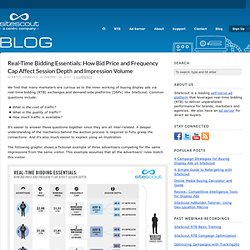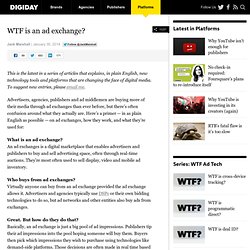

InStream video ads - Display Specs Help. How YouTube InStream Ads Work YouTube In-Stream Ads can run in video players appearing on YouTube watch pages and channel pages with featured videos.

These ads may run on YouTube desktop, mobile web and apps, connected TV, and game console properties, as well as the Google Video network and embedded YouTube players. Standard In-Stream Ads can be a maximum of 15 seconds (20 seconds in EMEA, 60 seconds skippable). How to know if your DSP is really working. Depending on who you ask, there are anywhere from 10-20 billion display impressions available globally each day for demand-side platforms (DSPs) and their clients to purchase on real-time bidding (RTB) sources like ad exchanges and supply side platforms (SSPs).

On top of that, some DSPs have now enabled buying of other types of media, including premium display, social, video, and mobile, bringing the total addressable ad inventory closer to something like 30 billion daily impressions that can be serviced through the execution and decisioning layer of a DSP. Let's put that in the context of a single advertiser. For easy math, let's say a display campaign spends $100,000 per month, or a little over $3,000 per day. At an eCPM of say $2.00, that's a little over 1.5 million impressions per day, or roughly 0.01 percent of the total available supply. You can start with retargeting, which we all know works, but has limited scale. How to know if your DSP is really working. Is CPM Bidding a Waste of Your Money? Ad Exchanges and DSPs explained. Before I explain Ad Exchanges and subsequently DSP (demand side platform), let me take you through the evolution of display advertising.

For those who came in late, Display advertising is advertising on the internet that appears alongside content on web pages in many forms, shapes and sizes varying anywhere from plain text to rich interactive multi-media banners. These ads are “published” on websites with the intent of inducing a reaction from the user (in the form of clicks, interaction with the banner or simply gathering attention) that will eventually benefit the advertiser. Now the distribution of these ads from the advertiser to the publisher has evolved over time, grown in complexity as the internet population grew and the stakes got higher. Traditional distribution of these ads involved three players – the advertiser, the publisher and the visitor (consumer, visitor to a website). Then there were three other issues with ad networks … The Ad Exchange Enter the DSP … What is Trading desk definition : The digital marketing glossary : illustrated terms and definitions.
A trading desk is a collection of human, organisational and technological means implemented to optmize digital advertisers’ budgets mainly through real time bidding and ad exchanges.

It’s a service dedicated to help advertisers and agencies buying online advertising. It can be also defined as an advertising technology platform combined with human skills in advertising and technology that constitutes an access point to the complex digital advertising marketplace. Within a trading desk, human ressources and skills are mainly software engineers, algorithm specialists, analysts and digital media strategists, account manager and buyers. Big agency trading desks count over 50 employees.
On the technological side, tools are essentially DSPs, APIs, DMPs and ad servers. What is the difference between "Agency Trading Desk (ATDs)" and "Trading Desk"? And What is the difference between ATDs and DSPs? Www.adexchanger.com/Agency_Trading_White_Paper.pdf. Real-Time Bidding Essentials: How Bid Price and Frequency Cap Affect Session Depth and Impression Volume. We find that many marketers are curious as to the inner working of buying display ads via real-time bidding (RTB) exchanges and demand-side platforms (DSPs) like SiteScout.

Common questions include: What is the cost of traffic? What is the quality of traffic? How much traffic is available? It’s easier to answer these questions together since they are all inter-related. The following graphic shows a fictional example of three advertisers competing for the same impressions from the same visitor. (click to enlarge) In this example, the visitor on a specific site views nine pages before leaving. (NOTE: Normally the lowest session depths are sold directly to advertisers by publisher sales teams or by ad networks selling this inventory on their behalf. RTB operates on a “second price” auction model, which means that each advertiser wins impressions sequentially at $0.01 higher than the next highest bidder. As you can see from the illustration above, the following rules hold true: 1. 2. 3. Real-Time Bidding Essentials: How Bid Price and Frequency Cap Affect Session Depth and Impression Volume. Display University/Display fundamentals/Networks & exchanges.
What is an Ad Exchange? This is the latest in a series of articles that explains, in plain English, new technology tools and platforms that are changing the face of digital media.

To suggest new entries, please email me. The Mechanics of Real-Time Bidding. Many newcomers to online ad buying have questions regarding the traffic they can buy through a demand-side platform (DSP).

How much does it cost? How much of it is available? What is the quality like? The answers are actually interrelated, and require an understanding of the mechanics behind how real-time bidding (RTB) works. Industry Terminology Explained First, a clarification of some industry terminology. Since most advertisers covet lower session depth (session depth refers to the number of pages viewed by a visitor in a particular viewing session, with lower depth corresponding to earlier views), publishers will often sell these impressions in bulk through direct deals with advertisers.